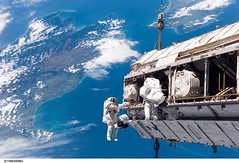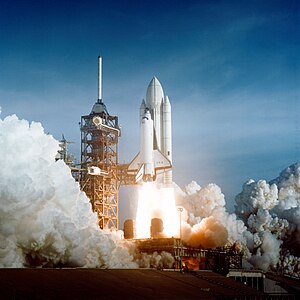Can’t fault the cable companies though, they do try to keep things interesting by constantly adding channels to the line-up.
Being an amateur astronomer, I was excited to see the new NASA TV channel – which is currently on free preview.
This channel came online just as the Space Shuttle was flying a mission to the International Space Station. It was really amazing to see live video broadcast directly from the shuttle, the space station and mission control down here on planet Earth.
 Image via Wikipedia
Image via Wikipedia
I watched as astronauts aboard the shuttle shifted the massive Canadian-built Space Arm to repair a satellite. I witnessed the live docking of the shuttle to the space station, and the warm greeting the astronauts gave each other upon opening the hatch, as they floated in space.
One of the most memorable images is that of Earth from space, as I saw a live video feed taken from the shuttle orbiting our blue-green planet. This was absolutely awe inspiring.
But when the astronauts are writing reports, conducting routine systems checks, or even just sleeping, the NASA TV channel quickly became just another pointless station on the dial. The images kept switching between mission control, and the shuttle, but there wasn’t anything going on – unless you enjoy watching people sitting behind computers typing.
The universe is a big place –there’s an understatement if there ever was one – the universe is MEGA HUGE. With the whole universe as its playground, you’d think the rocket scientists at NASA could create some interesting content for their TV channel.
NASA is the only organization to ever put a human on the moon, to land anything – even though they were robotic rovers – on Mars, and to successfully send probes into deep space and receive images and other scientific data from these probes – just to name a few of the National Aeronautic Space Agency’s (NASA) accomplishments.
It doesn’t take a rocket scientist to program a television station. With the amount of cool – and literally out of this planet – things NASA has accomplished, they should have no trouble airing interesting content that captivates the imaginations of those who may not have ever thought about astronomy, space exploration, or the any of the sciences.
Instead, for the most part the NASA TV channel is really dull. The “wow” factor of realizing the images are being beamed live from beyond our planet only lasts for a handful of minutes. Then the boredom of watching an astronaut reading in space sinks in, and you wonder who will ever pay for this channel?
That’s where the real problem will be, when this channel isn’t a free preview. Cable and satellite providers often place new channels on “free preview” for an introductory period, to generate interest in the channel, and get you to sign up for a subscription.
They are hoping you become addicted to a series on that station so much so, that you’ll gladly pay for a subscription.
But if the channel isn’t all that interesting, few subscribe to it, and it either is removed from the channel line-up, or becomes part of the regular subscription pack.
Take Teletoon Retro for a good example – a channel which shows old cartoons all day and all night. This channel was available to me as a free preview for over a year, and recently was added to my digital cable package free.

I enjoyed tuning in when it was on free preview, to watch some classic cartoons – like The Flinstones, The Jetsons, and Bugs Bunny and Friends. But I would never actually pay for this service – it isn’t something I’d watch often enough to justify the cost.
That kind of reasoning, or many others I’m sure, probably deterred people from subscribing to the channel. That’s why it was available for over a year – usually free previews are just that – a preview available for a limited time. And it is also why the channel is now part of my regular channel line-up. There simply weren’t enough subscribers to pay for the channel, so the cable company tossed it into the regular digital package.
Maybe the lack of creative ingenuity which is hitting the movie industry is also affecting television? With all the sequels, prequels and re-makes on the big screen, it appears no one has any original, interesting ideas anymore. Movies cost more, thanks to bigger movie theatres with higher quality picture and sound systems, but movies themselves are no better written – in fact they are
 Image by chatarra picks via Flickr
Image by chatarra picks via Flickr
Those creative geniuses bringing us new television channels, and shows on those channels must be suffering the same creative drought, if channels like NASA TV and Teletoon Retro are any indication.
And that’s really too bad, because of all the industries where creativity is king – television is supposed to rule.
![Reblog this post [with Zemanta]](http://img.zemanta.com/reblog_b.png?x-id=7236a1fe-2535-4e94-ad53-26ef2908c822)



![Reblog this post [with Zemanta]](http://img.zemanta.com/reblog_b.png?x-id=fc7ce72f-0e51-4059-9c39-43346c311e9d)

![Reblog this post [with Zemanta]](http://img.zemanta.com/reblog_b.png?x-id=ed43a82d-6eff-433c-806a-de4cbfdcafe5)







